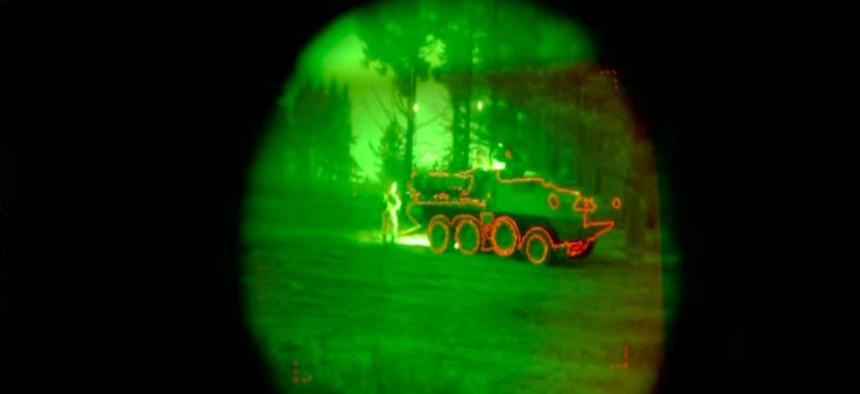New thermal night vision goggles penetrate dark, smoky battlefields
The latest Army night vision technology allows soldiers to fight near-peer adversaries in dark or smoky conditions.
The newest version of the Enhanced Night Vision Goggles (ENVG III) will give dismounted soldiers long-wave infrared sensor technology that penetrates a dark, smoky, or hidden battlefield like never before. And, it will be fielded by next year, according to Lt. Col. Anthony Douglas, Product Manager for Soldier Maneuver Sensors for Program Executive Office (PEO) Soldier.
“What makes version III of the ENVG better than version II is the thermal capability is much better,” explained Maj. Kevin Smith, Assistant Product Manager for FWS-I and Rapid Target Acquisition for PEO Soldier. “It has a higher resolution thermal camera.”
The thermal capability is provided by a long-wave infrared sensor, according to Maj. Smith. Infrared wavelengths are just past the portion of the electromagnetic spectrum visible to the human eye. Their own thermal sensitivity and ability to scatter invisible wave lengths, make infrared waves ideal for seeing through fog or smoke.
The latest technology is focused on improving performance and reducing costs for long wave infrared sensors by packing more pixels into each sensor. The technology uses vanadium oxide (VOx) to create microbolometers, which are the infrared wavelength detectors inside the sensor. When infrared wavelengths reflect off an object and hit the microbolometers, they heat up and use temperature differences to determine the shape of the object in question. The VOx microbolometer compacted-pixel technology is being developed by DRS Technologies, which is also one of the contractors for the ENVG.
An opportunity to try the equipment revealed that looking through the device, soldiers will see their surroundings in the classic green tint of night vision technology. However, people and other living objects now have a white glow, resulting from their body temperatures, that distinguishes them clearly from their surroundings. The demo presentation by Maj. Smith and Lt. Col. Douglas showed that a figure hidden behind thick foliage, invisible to the naked eye and to the standard PVS-14 night-vision device, was clearly visible through the ENVG III.
The ENVG III device itself is monocular and weights slightly less than one pound. It is secured to the soldier’s helmet and is powered by a detachable battery pack that clips onto the back of the helmet, under a protective flap. The eyepiece can be attached over either eye, depending on the soldier’s preference, said Maj. Smith.
In all, the ENVG III system, including the battery pack and harness that attach to the soldier’s helmet, will weigh less than two pounds.
“It’s designed primarily for the dismounted soldiers, and will be fielded to Infantry, Stryker, and Heavy Brigade Combat Teams,” explained Lt. Col. Douglas. It’s providing dismounted soldiers a thermal capability that mounted troops have had for a long time, he said.
Currently, almost every soldier is issued a PVS-14, explained Lt. Col. Douglas. It is a hand-held monocular image intensification device, which means it amplifies the minimal natural light in an environment, such as moonlight, so that objects can be seen. Yet, when there is no light to amplify, or when fog or smoke descends on the battlefield, image intensification technology is less effective.
“For the next fight, we anticipate…more of a conventional type force than we have now, and one of the main differences will be their ability to decrease battlefield visibility,” said Lt. Col. Douglas. For example, an adversary might use smoke to obscure targets.
However, “with the Enhance Night Vision Goggle, now you’re given that thermal capability, and because thermal goes through smoke, you can continue to acquire and engage,” continued Lt. Col. Douglas. “Thermal works during the day, in complete darkness, no moonlight, no light whatsoever. It’s a capability that the dismounted soldier didn’t have before,” he said.
The first version of the ENVG was fielded in 2012, according to Lt. Col. Douglas, and the second version followed in 2014. Now, the ENVG III is projected to reach squad leaders and team leaders in 2018.





